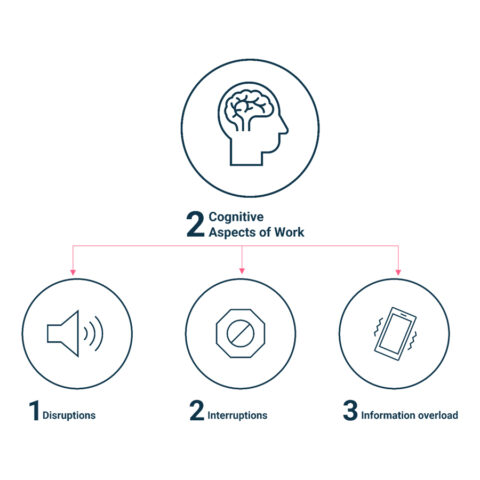Cognitive working ergonomics and cognitive strain in knowledge work
Working life has changed quite rapidly from manual work to knowledge work in the past decades. Human information-processing principles and brain structures have remained the same for at least 30,000 years, but the required information to be processed has grown exponentially (Kalakoski, 2019).
Because of this, the focus from physical working ergonomics should be widened to cover cognitive ergonomics. It is a crucial aspect of ergonomics for knowledge workers, as cognitive strain can have negative impacts on their working performance. Where traditional ergonomics is about physical aspects of work such as the workstation, cognitive ergonomics is aimed to support concentration, learning, and thinking in the working environment.
Characteristics of knowledge work
In knowledge work, the specific expertise of the workforce is the main resource. The nature of knowledge work is related to creativity, problem-solving, and task complexity instead of routine tasks, strict work processes, or structures. The value in knowledge work is created through knowledge rather than monotonous labor, and tasks are complex with a large amount of variety (Pyöriä, 2005).
On top of this, knowledge work usually demands continuous on-the-job learning, as well as creating and applying knowledge. Knowledge work requires a high degree of self-organization abilities by the employees. Work tasks can vary, and the work structure is open. The work is usually performed outside of the direct supervision of management which highlights the need for autonomy and independence. (Costas & Kärreman, 2016).
Based on these characteristics of knowledge work, cognitive ergonomics’ importance is underlined in order to have happy, healthy, and well-performing employees – the most important assets of knowledge-intensive organizations.
What is cognitive strain?
With poor cognitive ergonomics comes cognitive strain. It can be divided into three sources: disruptions, interruptions, and information overload.
- Disruptions; such as speech, noise, and moving elements around. For example, in an open-office premises
- Interruptions; such as co-workers asking for help, interaction technologies and notifications, missing information, or decision that blocks the continuity of work
- Information overload; such as multitasking, monitoring and observing several things in parallel, changing between tasks while working

Cognitive strain sources according to Työterveyslaitos (2023)
Effects of cognitive strain
Based on a qualitative research interview at Huld with small sample size and multiple studies from the field, there are several consequences of cognitive strain and how it hinders task performance and the overall well-being of employees in knowledge work.
Cognitive strain can reduce the quality of work due to increasing human errors and mistakes e.g., by not being able to identify detail-level faults or raising the risk of forgetting things and limiting the ability to manage large and complex entities. Also, the overall quality of work can be decreased on purpose if the employee is under pressure to complete assigned tasks on time.
Additionally, interview respondents stated that cognitive strain affects the ability to create new ideas and innovate new solutions, which is usually highly important in knowledge-intensive work. Schedule-wise, the cognitive strain may increase the number of unfinished tasks or increase the difficulty of decision making which can cause stretched schedules for projects. This may lead to time pressure and can cause irritation and dissatisfaction with the employee’s own work performance.
Cognitive strain may also have a negative impact on the work-life balance when the cognitive strain is affecting the energy levels outside of work due to work-based stress. This can raise the level of anxiety and mental illness.
How to improve cognitive ergonomics?
With better cognitive working ergonomics, we can minimize cognitive strain. The natural question is how to improve it. In the next blog post, I will share five steps for the transformation towards cognitively sustainable work life.
References
- Costas, J., & Kärreman, D. (2016). The bored self in knowledge work. Human Relations, 69(1), 61-83.
- Kalakoski, V. (2019). Cognitive Ergonomics is a Matter of Cognitive Factors. In ReCogErg@ ECCC (pp. 46-51).
- Paajanen, T. & Kalakoski, V. (2017). Mitä työterveyslääkärin tulisi tietää kognitiivisesta ergonomiasta? Työterveyslääkäri-lehti 35 (2), 16-21.
- Pyöriä, P. (2005). The concept of knowledge work revisited. Journal of knowledge management. 9 (3), 116-127.
- Työterveyslaitos. Kokonaisvaltainen ergonomia.
This blog is based on the final thesis for the writer’s MBA studies in University of Vaasa. Huld is a highly knowledge-intensive organization, and it matched well for the thesis topic which encouraged Juho to execute the research for Huld.
